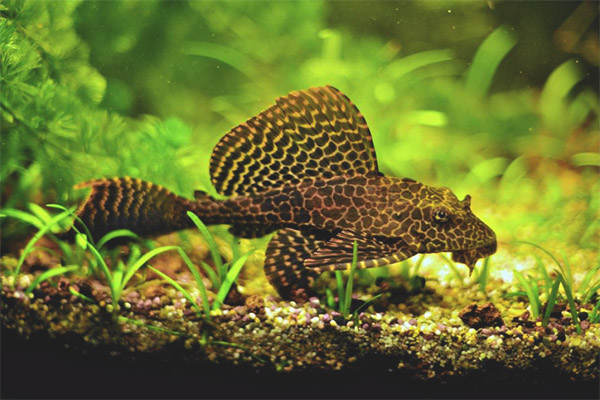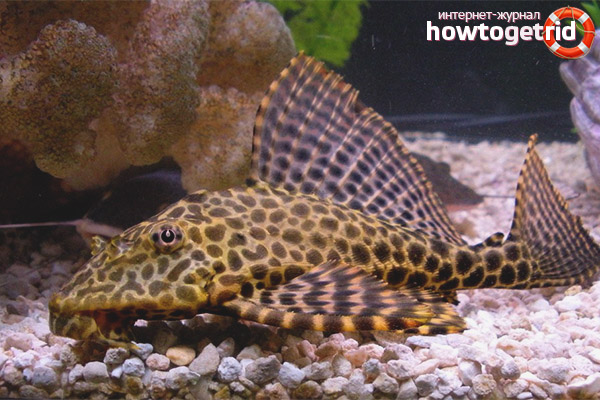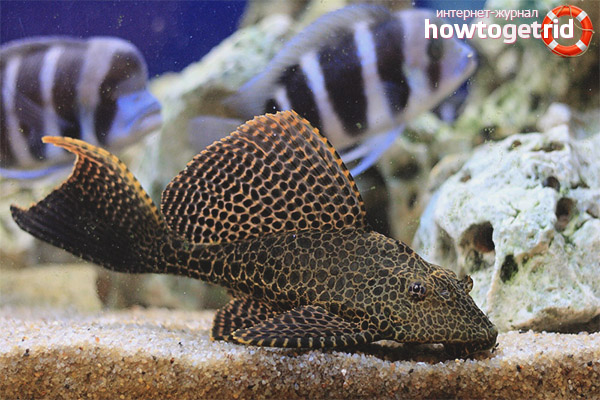The content of the article
- 1 Main features and description of brocade catfish
- 2 Natural habitat
- 3 Content of pterigoplicht in an aquarium: what should be considered?
- 4 Feeding pterigoplichtov
- 5 What you need to know about the content
- 6 Features reproduction: opportunities at home
- 7 Diseases characteristic of brocade catfish
- 8 Video: aquarium fish brocade pterigopliht
Brocade catfish or pterigoplicht is a popular and widely known fish among amateurs of aquarium dwellers. To date, the varieties of this aquarium inhabitant, there are more than a hundred species, and, as a rule, their main difference is the color. Nevertheless, people with experience will never confuse a different look with the brocade catfish, even if it is very similar to it, which is explained by the characteristic features of the appearance.
Main features and description of brocade catfish
The first mentions of the pterigoplicht catfish came to us from the distant 1854, it was then that this fish became known as a species thanks to the descriptions found by its scientists - naturalists.
This type is characterized by a number of certain characteristics:
- Aquarium catfish is a rather large fish that can reach 15-20 cm in size.
- A characteristic feature of the fish is the presence of the crest of the sail, which is located in the front of the hull and consists of a dozen rays. In the event that the number of ridges is less than ten, this is a similar, but still related to another type of fish.
- Somiki males on their pectoral fins have small formations resembling spikes.
- The unique leopard color of the fish is difficult to forget - neatly separated brown spots of a yellow border, covering the whole body of the fish along with fins, clearly distinguish it from other aquarian inhabitants. It is the spot pattern that determines the age of the catfish, the older it is - the more blurry it is.
- Pterigoplicht has small, but highly located eyes, while their iris duplicates the spotted color of the fish.
Natural habitat
Like most fish, the brocade catfish also has its own breeding method. For this, females are found in the river bed of the cavity where eggs are laid. Protecting the clutch, up to the appearance of fry - the task of the male.
In the wild, the size of the brocade catfish reaches half a meter, the duration of life is up to 20 years. The main food of fish is vegetation, however, it is considered omnivorous, as it can sometimes eat carrion.
A characteristic feature of the fish are suckers, with which it can be attached to vertical surfaces.
Content of pterigoplicht in an aquarium: what should be considered?
The brocade catfish has earned particular popularity among amateurs of aquarium fish due to the fact that it is, in fact, a fish cleaner. Directly the very content of this type is simple, just follow certain rules.
Aquarium Sizes
According to its volume, an aquarium for keeping adult pterigoplichts must be at least 300-400 l. This is explained by the fact that only in such conditions and with a sufficient volume of water will the fish feel most comfortable. Activity catfish increases closer to the night.In the wild during the daytime, they tend to hide in bottom caves. Accordingly, this should be considered when organizing the habitat for its aquarium pets.
Important! The aquarium should be located indoors in such a way that direct sunlight does not fall on it.
Aquarium Water Requirements
Water for the aquarium, designed to keep the brocade catfish, should be as close as possible to the usual for the fish in nature. That is, it should be not only pure, but also saturated with oxygen, with a moderate course. If an aquarium inhabitant began to protrude the muzzle out of the water, and swallowing some air is a clear indicator of insufficient aeration. In this case, you will need to equip the aquarium with an additional external filter.
The water in the aquarium should not be too hard, with indicators of hydrogen - 6.5-7.5, temperature parameters - + 24 ... + 30 ° С, water is changed weekly (no more than a quarter of the available volume). Some experts suggest that water changes should be performed daily.
What you should know about vegetation and soil
As well as water, vegetation and soil should be as close to natural as possible - this will help all the inhabitants of the aquarium to feel good. As the substrate is better to use small stones (pebbles). All aquarium plants should have sufficiently long roots, well fixed with stones, otherwise the fish simply pulls them up and eats them.
The use of additional equipment
I would like to note that one of the main conditions for the proper maintenance of the brocade catfish is the obligatory presence in the aquarium of such an element as an ordinary snags. This is because fish need pulp for proper digestion. For this purpose, a specially selected stick is placed in the aquarium, with which the catfish will subsequently scrape off the growths.
Feeding pterigoplichtov
Pterigoplicht feeding ration is food of plant and animal origin (80:20 ratio). The practical application of these recommendations involves feeding the fish mostly green vegetables. Note that the lack of plant food in the aquarium pet diet often leads to the fact that over time the fish destroys all the vegetation in the aquarium.As a feed of animal origin, you can use products offered by specialized pet stores (for example, bloodworms are perfect for this).
It is important to take into account that feeding with animal feed must also be complete. Otherwise, pterigoplichts may begin to devour the scales from the sides of the slower and shallower neighbors in the aquarium. Since the activity of these fish increases at night, according to their feeding should be carried out in the evening (preferably late at night, before turning off the light in the room at night).
What you need to know about the content
The predatory inhabitants of the aquarium do not frighten the brocade catfish at all; as a rule, it simply ignores them. The natural and strong protection of the fish against any opponent is a reliable, armored body.
In general, aquarium catfish can be called good neighbors and loyal assistants to their owners. This is explained by the fact that how many years this fish lives - as much it helps to efficiently clean the home aquarium. The average life expectancy of pterigoplichtov is about fifteen years.
Features reproduction: opportunities at home
Unfortunately, this type of fish in the aquarium can not be propagated. The reason for this - the lack of natural conditions. As a rule, the artificial breeding procedure of this species is performed exclusively on special farms. The reproduction of these fish is a profitable and highly profitable business.
Diseases characteristic of brocade catfish
Pterigoplicht is a fish that is distinguished by good immunity, which indicates its high resistance to many diseases affecting other inhabitants of aquariums. The main problem of the fish can be digestive problems due to lack of cellulose.
Video: aquarium fish brocade pterigopliht













To send